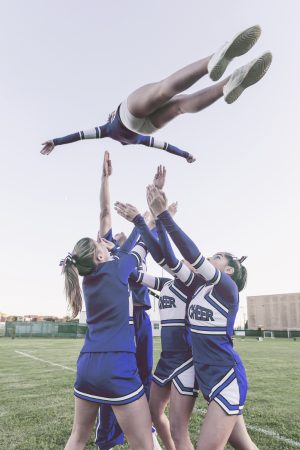
Cheerleading: Fact vs. Fiction
Leave a CommentCheerleading is rising in popularity and its composition has changed significantly over the decades.
Despite its popularity, there are still many things people don’t know about cheerleading. While some wonder if cheerleading is even a sport, others wonder if it could actually be the most dangerous sport. To help answer some of these questions, we are separating the cheerleading facts from fiction below:
1. Cheerleading is a Sport: TRUE! According to the Oxford Dictionary, “Sport” is defined as an activity involving physical exertion and skill in which an individual or team competes against another or others for entertainment.
 Cheerleaders fall into this category. These athletes tumble, jump, use their muscles to lift each other into impressive stunts, and at the end of a routine their heart rate is elevated. Cheerleaders also compete at local, state and national competitions, oftentimes this is in addition to supporting their home team at games. It is important to consider cheerleading a sport in order to prevent injury. This is because organizations that label cheerleading as a sport tend to have better practice and competition equipment, as well as access to athletic trainers.
Cheerleaders fall into this category. These athletes tumble, jump, use their muscles to lift each other into impressive stunts, and at the end of a routine their heart rate is elevated. Cheerleaders also compete at local, state and national competitions, oftentimes this is in addition to supporting their home team at games. It is important to consider cheerleading a sport in order to prevent injury. This is because organizations that label cheerleading as a sport tend to have better practice and competition equipment, as well as access to athletic trainers.
2. Cheerleading is the Most Dangerous Sport: FALSE! According to a study in the Journal of Pediatrics, cheerleading ranks 18th out of 22 for overall number of injuries. What’s more, the study shows that concussion injury rated lower than all other high school sports combined and often was a result of a base being hit by the flyer.1
This data doesn’t mean that cheerleading is free from danger. In fact, a separate study shows that serious injuries that involve permanent disability may rank higher in the sport of cheerleading. These serious injuries are termed “catastrophic injury,” which includes fatalities, severe disability or serious injury without permanent disability.2 Cheerleading sits behind football as second in the catastrophic injury category. Overall injury can be prevented by implementing quality conditioning programs, working with well-trained coaches and utilizing safe practicing equipment.
3. Cheerleaders are Very Flexible and Strong: TRICK QUESTION! BOTH TRUE AND FALSE! Although each athlete is different, patterns of tightness and weakness are often found when screening cheerleaders. As with many sports, some muscles will become naturally stronger and more flexible, while others will be weaker and tighter due to the positioning of the skills practiced. Correction of these muscle imbalances is important to enhance skill level and prevent injury. For further reading on cheerleading specific muscle imbalances, check out Athletico’s “Correction of Muscle Imbalances for Gymnasts and Cheerleaders.”
4. Cheerleading is a Female-Only Sport: FALSE! Cheerleading was actually started by a group of men at the University of Minnesota in 1903. Additionally, females were not added onto cheer squads until the 1920s.3 Of course back then cheerleading consisted of leading the crowd on cheering on the team only. Now, men on cheer teams are dynamic tumblers and can be integral in stunts, including holding other cheerleaders overhead with one hand!
5. Athletico has a Cheerleading Program: TRUE! Athletico has a Gymnastics and Cheerleading program consisting of several physical therapists, occupational therapists and athletic trainers. This program meets a few times per year to discuss the most relevant research and share treatment ideas that are specific to treating gymnasts and cheerleaders. This means that if you tell us that you were injured doing a double full, we know what that means and how to get you back to doing that double full! Our participants in the program have personal sport experience in many cases ranging from high school to Olympic-level skill. Learn more and find a cheerleading specialist near you by checking out our Gymnastics and Cheerleading Rehabilitation program page, or requesting an appointment.
Click to Request an Appointment
The Athletico blog is an educational resource written by Athletico employees. Athletico bloggers are licensed professionals who abide by the code of ethics outlined by their respective professional associations. The content published in blog posts represents the opinion of the individual author based on their expertise and experience. The content provided in this blog is for informational purposes only, does not constitute medical advice and should not be relied on for making personal health decisions.
- Welsh, A. (2015, December 10). Cheerleading injuries less common, more sever than other sports. Retrieved from www.cbsnews.com/amp/news/cheerleading-injuries-less-common-more-severe-than-other-sports/?
- Mueller, F., et al. (2013, Sprine). Catastrophic Sports Injury Research Thirty-First Annual Report from the National Center for Catastrophic Sport Injury Research at The University of North Carolina at Chapel Hill.
- History of Cheerleading. Retrieved from https://cheerleading.isport.com/cheerleading-guides/history-of-cheerleading.
